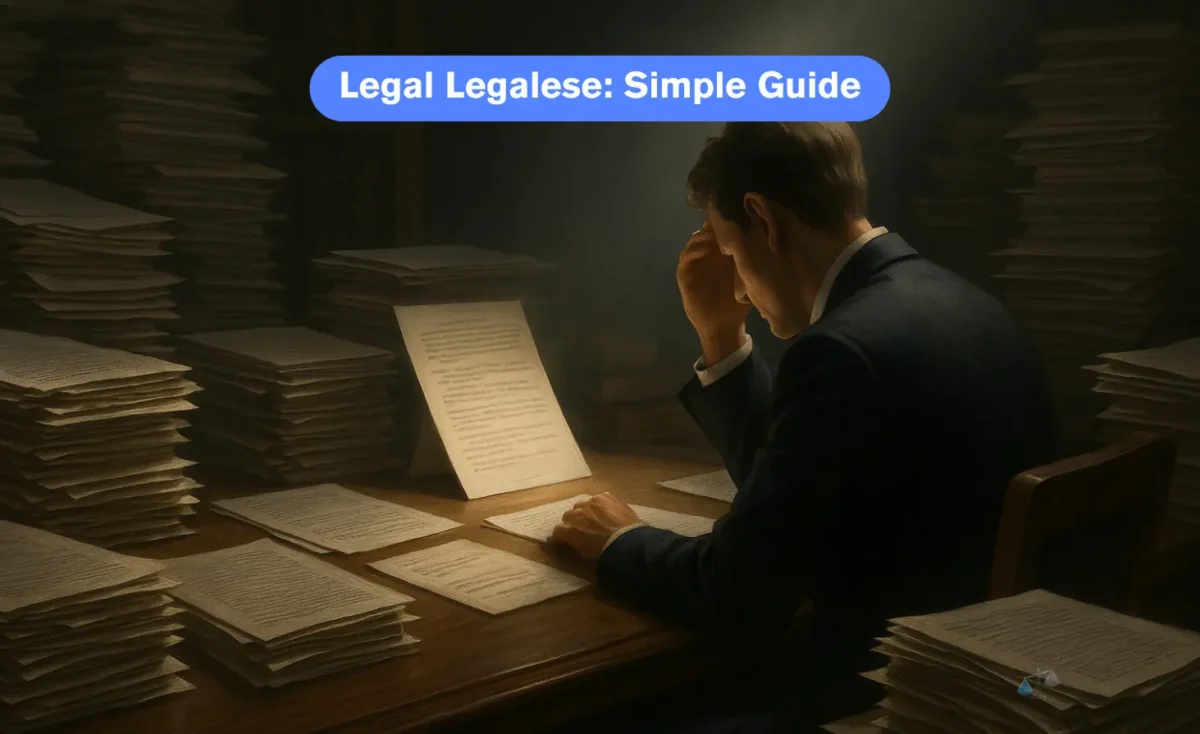Legal Legalese: Definition and Examples Guide

Definition of Legal Legalese: Legalese is the specialized and often complex style of language used in legal writing. It includes long, formal sentences, redundant expressions, and technical terms that make legal documents difficult for ordinary readers to understand.
In simple terms, legalese means “the complicated language of law” — a form of writing designed for precision and tradition rather than clarity.
“Legalese speaks the language of precision, but not always the language of people.”
Legalese appears in contracts, statutes, court filings, and even public notices.
It originated as a way to prevent ambiguity and ensure legal certainty.
However, as law evolved, this form of writing became a double-edged sword — admired for its accuracy, yet criticized for alienating those it governs.
Origins and Historical Development of Legal Legalese
The history of legalese stretches back nearly a millennium.
Its roots lie in the blending of Latin, Law French, and Early English, languages used in medieval courts and royal charters. When English gradually replaced Latin in the 14th century, many old words and grammatical structures remained, giving rise to the legal dialect still used today.
| Period | Language Used in Law | Impact on Legal Writing |
|---|---|---|
| 11th–14th Century | Latin & Law French | Introduced technical phrasing and formality. |
| 15th–17th Century | Early Modern English | Translation preserved archaic terms and syntax. |
| 18th–20th Century | Legal English | Codified complexity as a mark of professionalism. |
| 21st Century | Plain Language Era | Push for clarity and accessibility. |
Common examples such as “heretofore,” “aforesaid,” “witnesseth,” and “hereinafter” remain in modern contracts, though their practical meaning is minimal. They persist largely because legal writers continue to rely on precedent rather than adaptation. The language of law evolved not by clarity, but by repetition.
Key Characteristics of Legal Legalese
Legalese is recognizable by its structure, tone, and rhythm.
It reflects the lawyer’s pursuit of exactness — but often at the cost of readability.
1. Archaic Vocabulary
Terms like herewith, aforesaid, and heretofore date back to early English law, surviving centuries despite simpler alternatives.
2. Redundant Expressions
Double or triple phrases (e.g., null and void, cease and desist, terms and conditions) reflect a historic habit of pairing synonyms from Latin and Germanic roots for certainty.
3. Passive and Impersonal Style
Instead of “The court ruled,” legalese prefers “A determination was made by the court,” distancing the subject and dulling clarity.
4. Formulaic Sentence Structure
Repetitive clauses such as “the party of the first part” or “said property hereinafter described” create formality but reduce natural flow.
5. Latin and French Loanwords
Phrases like inter alia, ipso facto, and de jure signal authority and tradition — yet they obscure meaning for lay audiences.
“Legalese survives because it sounds like law, even when it hides what law means.”
Why Legalese Persists in Modern Law
Despite decades of criticism, legalese continues to dominate legal documents across the world.
Its endurance is not an accident — it reflects deep institutional habits, professional caution, and the desire for linguistic precision.
1. Tradition and Precedent
Law is a field built upon precedent. Once a specific phrase proves enforceable in court, lawyers hesitate to replace it.
Phrases like “cease and desist” or “for the avoidance of doubt” survive because they have been judicially interpreted many times, giving them reliable meaning.
Lawyers often write not to persuade the reader, but to protect the record.
The fear of altering a tested formula discourages simplification.
Thus, legalese persists as a kind of linguistic fossil — kept alive by caution rather than necessity.
2. Ambiguity Avoidance
Legal documents must anticipate every possible interpretation.
Each word carries potential consequences in litigation.
By stacking synonyms and repeating clauses, legal drafters try to eliminate uncertainty — but the result is often overkill.
Example:
“The lessee shall pay rent on the first day of each and every calendar month without demand.”
This line could be written simply as “The tenant must pay rent monthly,” but lawyers prefer the longer form because courts have upheld it before.
In this sense, legalese is not about beauty or readability — it is about defensibility.
3. Institutional Inertia
Legal writing is transmitted from mentor to associate, from precedent to precedent.
Young lawyers imitate the templates of senior attorneys, who in turn inherited their forms from generations before them.
As a result, legalese functions like a professional dialect — one that signals membership in the legal community.
Sociolinguistic Viewpoint:
Legalese reinforces hierarchy: those who understand it belong inside the circle of legal authority; those who do not remain outside.
Complexity becomes a gatekeeper, not a guide.
Criticisms and Drawbacks of Legal Legalese
While legalese may offer certainty, it does so at a significant social cost.
Critics argue that the language of law — meant to govern all citizens — becomes inaccessible to the very people it affects.
1. Barrier to Public Understanding
Ordinary citizens struggle to comprehend contracts, policies, and rights written in dense legal jargon.
This lack of clarity undermines informed consent, especially in consumer and employment contexts.
2. Inefficiency and Misinterpretation
Long, repetitive drafting wastes time and increases the likelihood of misreading.
Even judges have criticized filings as “unnecessarily verbose and obscure.”
3. Erosion of Trust
When legal communication feels impenetrable, it alienates clients and fosters suspicion toward lawyers and institutions. Transparency suffers, and law appears to be a private language for professionals rather than a public safeguard. Law loses authority when it hides behind language.
The Rise of Plain Language Reform
Since the late 20th century, governments and professional associations have promoted plain language movements — initiatives encouraging lawyers to write in clear, direct, and accessible English.
Key Milestones:
- 1970s: Plain English Campaign in the United Kingdom launches public awareness efforts.
- 1998: U.S. Securities and Exchange Commission (SEC) mandates “plain English” in investor documents.
- 2010: The U.S. Plain Writing Act requires federal agencies to use straightforward language in public materials.
Core Principles of Plain Legal Writing
- Use short sentences and everyday vocabulary.
- Prefer active voice: “The court decided” instead of “It was decided by the court.”
- Avoid redundant phrases.
- Organize information with headings and lists.
- Define essential terms clearly once — not repeatedly.
Example Comparison:
| Traditional Legalese | Plain English Equivalent |
|---|---|
| “The party of the first part shall indemnify and hold harmless the party of the second part.” | “The tenant agrees to protect the landlord from any claims or losses.” |
Plain language reform does not seek to simplify the law — only the way it is communicated.
Clarity is not the enemy of precision; it is its greatest proof.
How Legalese Shapes Legal Identity and Authority
Legalese is more than a writing style — it is a symbol of professional authority.
By mastering a specialized vocabulary, lawyers distinguish themselves from ordinary speakers, reinforcing law’s image as a technical and exclusive discipline.
1. The Professional Dialect of Lawyers
Like medical or scientific jargon, legalese functions as an in-group language.
It allows precision and consistency across jurisdictions but also separates the legal community from laypeople.
In many cultures, this linguistic separation reinforces the idea that law is not merely written — it is interpreted by experts.
To understand the law, one must first decode its language.
However, this identity-driven approach has a cost.
Overreliance on jargon can create linguistic inequality, where citizens depend entirely on lawyers to understand their own rights.
The law becomes a closed conversation between professionals, leaving outsiders silent.
2. Legalese and the Myth of Precision
Supporters of legalese argue that complexity ensures precision.
Yet, modern linguistic studies show that clarity and accuracy can coexist.
Excessive verbiage often hides — rather than clarifies — meaning.
Example:
Instead of writing “The aforesaid party shall be obligated to remit payment in a timely fashion,”
a lawyer could write “The buyer must pay on time.”
Both mean the same, but the second invites no confusion.
Empirical Findings:
Research by the American Bar Foundation indicates that contracts written in plain English reduce litigation risk by up to 25%, as parties better understand their obligations.
A precise law must first be understood to be obeyed.
Modern Trends in Legal Drafting
The legal profession is slowly evolving.
Technological tools, client expectations, and cross-border collaboration demand shorter, clearer, and digitally compatible documents.
1. Contract Simplification
Corporations and governments now invest in redesigning traditional agreements for clarity.
For example:
- IBM and General Electric replaced dense legal templates with visual, plain-language contracts.
- The European Union publishes multilingual legal materials emphasizing parallel simplicity.
- Legal design firms now merge lawyers with information designers to make contracts readable and user-centered.
2. Digital Transformation
With online platforms and AI-assisted drafting, legal documents are no longer static.
Modern systems analyze readability scores and flag ambiguous terms automatically, nudging lawyers toward clarity.
| Drafting Era | Defining Feature | Objective |
|---|---|---|
| Pre-2000 | Tradition & precedent | Precision through repetition |
| 2000–2020 | Reform & modernization | Balance clarity with enforceability |
| 2020–Present | Digital standardization | Readability, transparency, automation |
The future lawyer will not write more words — they will write clearer ones.
Case Studies: Plain Language in Action
1. The U.S. Federal Government
Since the Plain Writing Act of 2010, all federal agencies must draft regulations and forms in clear English.
The change improved public compliance and reduced administrative disputes.
2. New Zealand and Canada
Courts in both countries have endorsed simplified contracts and jury instructions.
Judges emphasize that justice must be understood to be served.
3. The Private Sector
Financial institutions and insurance companies increasingly publish consumer-friendly versions of legal terms — proving that transparency can coexist with enforceability.
Outcome:
Client trust improves, legal misunderstandings drop, and overall document engagement rises.
The Future of Legalese: From Tradition to Technology
As the legal industry undergoes digital transformation, the role of legalese faces an existential question — can machines understand the language of law if humans barely can?
1. AI and Legal Language Simplification
Artificial intelligence now drafts, reviews, and summarizes legal documents.
However, AI systems perform best when fed with clear, structured language, not dense jargon.
This pressure is accelerating the decline of traditional legalese, as firms adopt standardized, machine-readable formats.
Example Applications:
- Contract lifecycle software rewriting clauses in plain English.
- AI tools identifying redundant expressions like null and void or hereinafter referred to.
- Legal chatbots explaining terms to clients in simple, conversational language.
The clearer the law is, the smarter technology becomes.
2. The Ethical Boundary
Simplification cannot come at the cost of precision.
Over-simplifying may distort meaning in critical areas like constitutional law or financial regulation.
Therefore, legal professionals must balance accessibility with accuracy — rewriting, not diluting, the law.
Ethical Considerations:
- Maintain the integrity of original intent.
- Preserve legal nuance while improving readability.
- Ensure transparency when AI assists in drafting or summarization.
The challenge ahead is to design a legal language that remains precise enough for courts and clear enough for citizens.
Simplicity without accuracy is just a different kind of confusion.
3. Toward a Bilingual Future: Law and Clarity
Legal experts increasingly advocate for a “dual register” approach — one version written in professional legal English for recordkeeping, and another in plain English for public use.
This balance may represent the future of legal communication.
Predicted Trends:
- Statutory interpretation guides translated into plain language.
- Bilingual legal drafting tools embedded in AI software.
- Legal education focusing on communication as much as case law.
When law becomes both accessible and accurate, legalese may evolve rather than disappear — transforming from an obstacle into a foundation for clear, universal understanding.
FAQ — Legal Legalese
What does “legalese” mean?
Legalese is the formal and technical language used in legal documents. It is known for its complex sentences, archaic terms, and redundant expressions that make the law difficult to read for non-lawyers.
Why do lawyers still use legalese?
Because it provides precision and consistency. Many phrases in legalese have been tested in court, making them safe and reliable — though not always reader-friendly.
What are common examples of legalese?
Expressions like heretofore, aforesaid, null and void, and the party of the first part are classic examples of outdated legalese still found in contracts and statutes.
Why is legalese criticized?
It creates barriers between legal professionals and the public, reducing transparency and comprehension.
Critics argue that the law should be understandable to everyone it governs.
What is the Plain Language Movement?
It is a global reform effort encouraging lawyers and lawmakers to use clear, direct English in all legal documents while maintaining legal accuracy.
Can AI replace legalese?
AI helps reduce unnecessary complexity but cannot yet interpret all legal nuances. The future of legal writing likely involves collaboration between human expertise and AI-driven clarity tools.
Is it possible to write legally valid contracts without legalese?
Yes. Modern drafting techniques prove that contracts written in plain, clear English are equally enforceable — and often more effective in preventing disputes.
Author Note
This article explains the meaning, origins, and transformation of legalese — the formal language of law — and how modern reform movements aim to balance clarity with precision.
It is intended for educational purposes only and does not constitute legal advice.
Readers should consult licensed attorneys for jurisdiction-specific requirements or professional drafting guidance.
Author: Legal Terms
Last Updated: October 12, 2025
Table of Contents For Legalese
Keywords For Legal Legalese
- Legal Legalese
- Meaning of Legal Legalese
- Legal Framework For Legalese
- Practical Applications For Legalese
- Legal and Practical Importance
- Limitations and Enforcement






